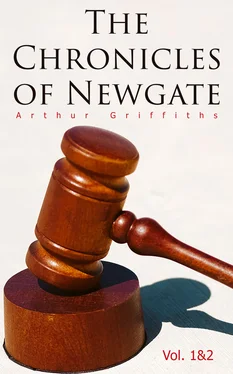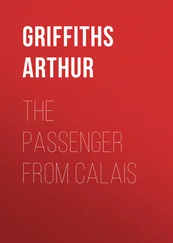To his great misfortune he now fell in with one Captain Rookwood. It was about the time of the discovery of the assassination plot, of which Major Bernardi declares that he was in absolute ignorance till he heard of it like the rest of the world. He was by chance in the company of Captain Rookwood at a tavern, and was with him arrested on suspicion of being “evil-minded men.” While in the Compter Rookwood incautiously revealed his own identity, and was lost. Rookwood seems at the same time to have unintentionally betrayed Bernardi, whose name had, it appears, and in spite of his protestations of perfect innocence, been included in a proclamation. The inference is that the Government was in the possession of certain information that Bernardi was mixed up in the plot.[103] Both men were carried before the Council, and committed close prisoners to Newgate, “loaded with heavy irons, and put into separate dismal, dark, and stinking apartments.” Rookwood was speedily condemned and executed at Tyburn. Bernardi remained in prison without trial, until after Sir John Fenwick had suffered. Then with his fellow-prisoners he was taken to the Old Bailey to be bailed out, but at the instance of the Treasury solicitor, who “whispered the Judges upon the Bench,” they were relegated to Newgate, and a special Act passed rapidly through the House to keep them for another twelve-month on the plea of waiting for further evidence against them. A second Act was passed prolonging the imprisonment for another year; then a third, to confine them during the king’s pleasure. On the death of the king (William III.), a fresh Act extended the imprisonment during the reign of Queen Anne. During this long lapse of time repeated applications were made to Judges, but the release of the prisoners was always bitterly opposed by the law officers. Bernardi’s doctors certified that imprisonment was killing him; he suffered from fits and the constant trouble of an old wound. Nevertheless he lived on; and when in his sixty-eighth year he married, in Newgate, a second, virtuous, kind, and loving wife, who proved “a true help-meet,” supporting him by her good management, and keeping his heart from breaking in the “English Bastille.” Bernardi had ten children born in Newgate of this second wife. The imprisonment continued through the reigns of George I. and II. Frequent petitions were unheeded, and finally Bernardi died in Newgate in 1736, the last survivor, after forty years’ incarceration, and aged eighty-two.
Table of Contents
Reasons for legal punishments—Early forms: branding, mutilation, whipping, the pillory, and stocks—Penalties for females: the ducking-stool, branks, and scourge—Capital punishment universal—Methods of inflicting death—Awful cruelties—The English custom—Pressing to death—Major Strangways—Spiggot and Burnworth—Abolition of this punishment—Decapitation and strangulation—The guillotine and gallows—Places of execution in London: Smithfield, St. Giles, Tower Hill, Tyburn—Derivation of Tyburn—Site of Tyburn gallows—Tyburn a generic title—An execution in 1662: that of Colonel Turner—Crowds at executions—Fashionable folk attend—George Selwyn—Breakfast party at Newgate—Ribald conduct of the mob at executions—That of Earl Ferrers and of Sheppard—Demeanour of condemned: effrontery, or abject terror—Improper customs long retained—St. Giles’ Bowl—Saddler of Bawtry—Smoking at Tyburn—Spiritual attentions of Ordinary not always devoted—Amateur preachers and others assist—Richard Dove’s bequest—The hangman and his office—Resuscitation—Early cases—Sir William Petty’s operation—Tyburn procession continues—Supported by Dr. Johnson—Sheriffs suggest discontinuance—Their reasons—The front of Newgate substituted as the scene of execution.
THE universal instinct of self-preservation underlies the whole theory of legal punishments. Society, since men congregated together, has claimed through its rulers to inflict penalties upon those who have broken the laws framed for the protection of all. These penalties have varied greatly in all ages and in all times. They have been based on different principles. Many, especially in ruder and earlier times, have been conceived in a vindictive spirit; others, notably those of the Mosaic law, were retaliatory, or aimed at restitution. All, more or less, were intended also to deter from crime. The criminal had generally to pay in his person or his goods. He was either subjected to physical pain applied in degrading, often ferociously cruel ways, and endured mutilation, or was branded, tortured, put to death; he was mulcted in fines, deprived of liberty, or adjudged as a slave to indemnify by manual labour those whom he had wronged. Imprisonment as practised in modern times has followed from the last-named class of punishments. Although affecting the individual, and in many of its phases with brutal and reckless disregard for human suffering, it can hardly be styled a purely personal punishment, upon which I propose now more particularly to treat, and the present chapter will deal only with penalties corporeal.
Taking first the punishments which fell short of death, those most common in this country until comparatively recent times, were branding, mutilation, dismemberment, whipping, and degrading public exposure. Branding was often carried out with circumstances of atrocious barbarity. Vagabonds were marked with the letter V, idlers and masterless men with the letter S, betokening a condemnation to slavery; any church brawler lost his ears, and for a second offence might be branded with the letter F, as a fraymaker and fighter. Sometimes the penalty was to bore a hole of the compass of an inch through the gristle of the right ear. Branding was the commutation of a capital sentence on clerk convicts, or persons allowed benefit of clergy, and it was inflicted upon the brawn of the left thumb, the letter M being used in murder cases, the letter T in others. In the reign of William and Mary, when the privilege of benefit of clergy was found to be greatly abused, an Act was passed, by which the culprit was branded or “burnt in the most visible part of the left cheek nearest the nose.” Mutilation was an ancient Saxon punishment, no doubt perpetuating the Mosaic law of retaliation which claimed an eye for an eye, a tooth for a tooth, a limb for a limb. William the Conqueror adopted it in his penal code. It was long put in force against those who broke the forestry laws, coiners, thieves, and such as failed to prove their innocence by ordeal. Although almost abandoned by the end of the sixteenth century, the penalty of mutilation, extending to the loss of the right hand, still continued to be punishment for murder and bloodshed within the limits of a royal residence. The most elaborate ceremonial was observed. All the hierarchy of court officials attended; there was the sergeant of the woodyard, the master cook to hand the dressing-knife, the sergeant of the poultry, the yeoman of the scullery with a fire of coals, the sergeant farrier who heated and delivered the searing irons, which were applied by the chief surgeon after the dismemberment had been effected. Vinegar, basin, and cloths were handed to the operator by the groom of the salcery, the sergeant of the ewry, and the yeoman of the chandrey. “After the hand had been struck off and the stump seared, the sergeant of the pantry offered bread, and the sergeant of the cellar a pot of red wine, of which the sufferer was to partake with what appetite he might.”[104] Readers of Sir Walter Scott will remember how Nigel Olifaunt, in the ‘Fortunes of Nigel,’ was threatened with the loss of his hand for having committed a breach of privilege in the palace of Greenwich and its precincts. Pistols are found on his person when he accidentally meets and accosts James I. For the offence he may be prosecuted; so Sir Mungo Malagrowther complacently informs him, usque ad mutilationem even to dismemberation. The occasion serves the garrulous knight to refer to a recent performance, “a pretty pageant when Stubbs the Puritan was sentenced to mutilation for writing and publishing a seditious pamphlet against Elizabeth. With Stubbs, Page the publisher also suffered. They lost their right hands,” the wrist being divided by a cleaver driven through the joint by the force of a mallet. “I remember,” says the historian Camden,[105] “being then present,
Читать дальше












